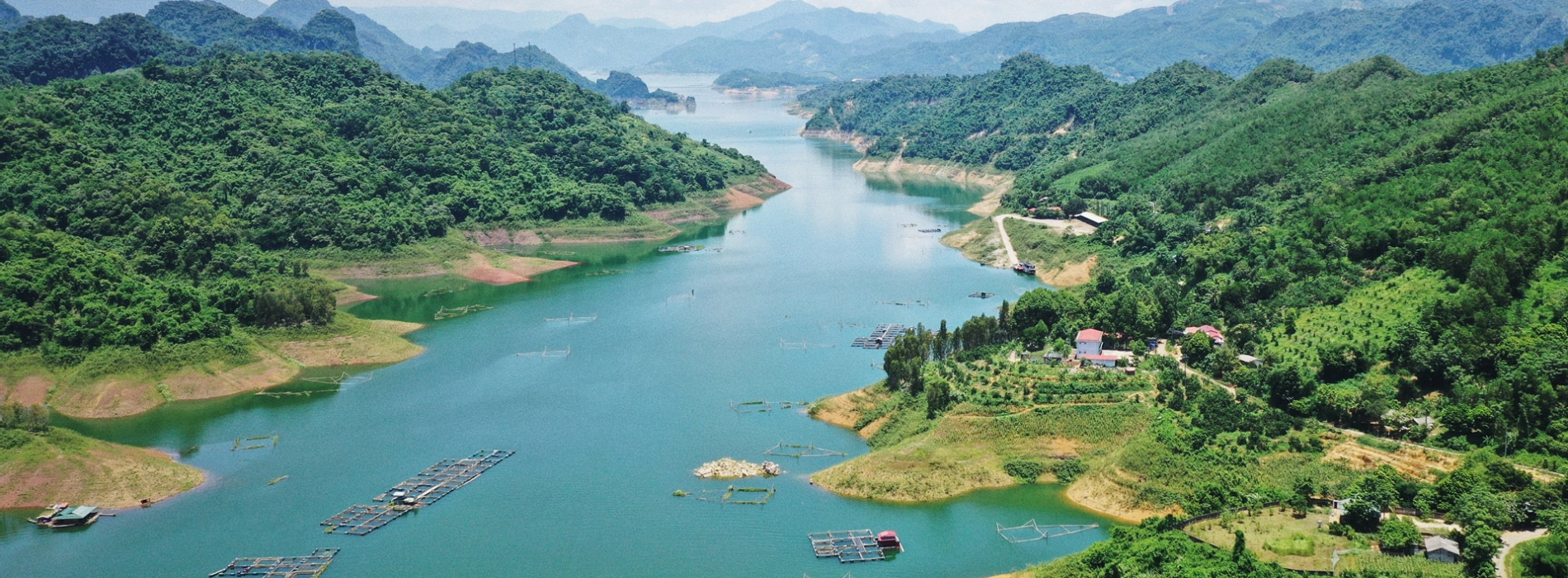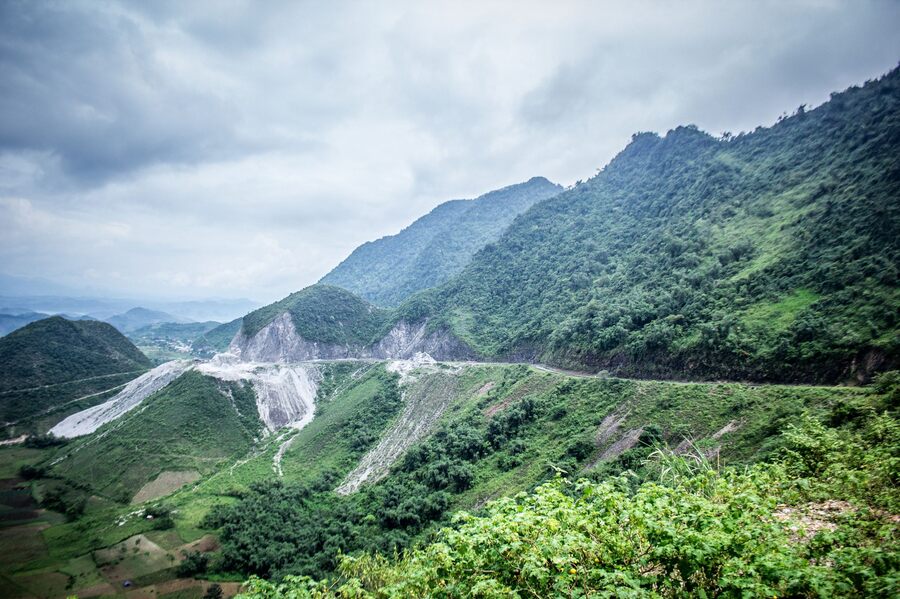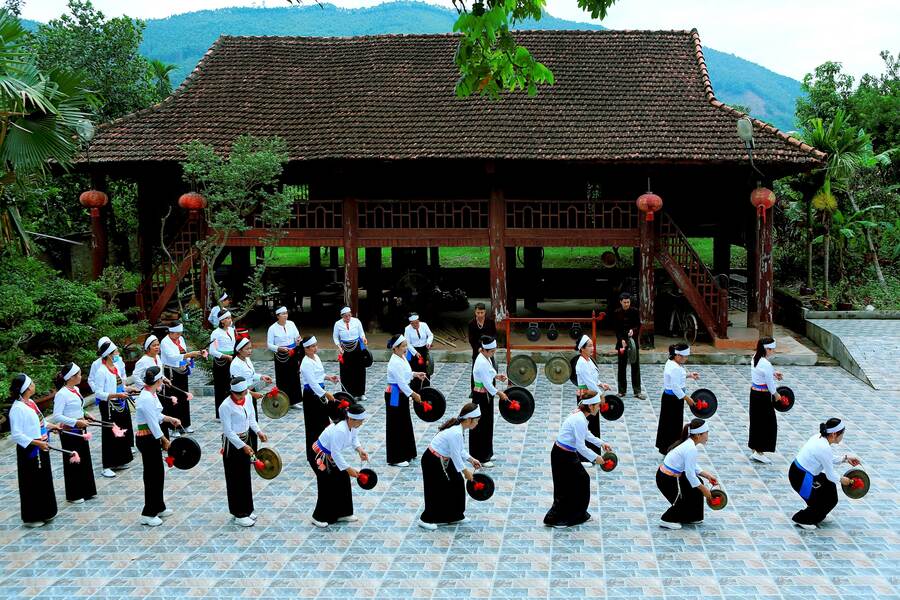Hoa Binh

Hoa Binh Province borders the capital Hanoi to the west, serving as a transition between the Red River Delta and the Northwestern mountainous region. The province's topography stretches from plains to high mountains, along with large rivers flowing through, resulting in many beautiful natural landscapes.

Hoa Binh City on Da River. Photo: Hoa Binh People's Committee
Not only that, the culture of the ethnic minorities also creates new and unique experiences for each visitor. The area was originally inhabited by ethnic minority groups like the Muong people, who have called these misty mountains and winding rivers home for centuries. Let’s discover the mountains, the rivers and the people of Hoa Binh in the following article.
Many archaeological sites in the province show the human presence from the Neolithic period. Over the next few centuries, the culture and language of the Muong people gradually merged with that of the Vietnamese majority.
During the Nguyen Dynasty, the area belonged to Son Tay Province. It was separated and established in 1886 under the name Muong Province. After Nguyen Duc Ngu's attack in 1891, the French moved the provincial capital to Hoa Binh Commune and renamed the province Hoa Binh.

Hoa Binh Hydroelectric Power Plant - the pride of Vietnam in the late 20th century. Photo: Xay dung 47
The province became a hotbed of Vietnamese nationalist resistance against the French. The rugged terrain made it an ideal staging area for revolutionaries like Ho Chi Minh and the Viet Minh forces during their struggle for independence in the 1940s and 1950s. The Battle of Hoa Binh in 1951-1952 was a game-changer in the First Indochina War against the French.
Even after Vietnamese independence, Hoa Binh continued to play a strategic role during the Vietnam War in the 1960s and early 1970s as a stronghold for North Vietnamese forces operating in the region. Today, this province wears its revolutionary heritage as a badge of honor.
Hoa Binh Province is in northwest Vietnam, roughly 76 kilometers southwest of Hanoi city center. This mountainous province shares borders with several other provinces, including Phu Tho to the northeast, Son La to the northwest, Thanh Hoa to the south, and Ninh Binh to the southeast.

The province's main attraction is the mountains and valleys. Photo: Crystal Bay
From Hanoi, it takes around 2 hours to reach the provincial city by car. Despite close to Hanoi, Hoa Binh feels like a world away, with its rugged terrain, winding roads, and stunning natural landscapes.
Anyone afar wants to fly in, the closest airport is Noi Bai International Airport in Hanoi. You can grab a taxi or book a private transfer from the airport to your hotel. For those road-tripping, the drive from Hanoi is an easy 2-hour journey along National Highway 6.

Thung Khe Pass not only stands out for its white cliffs but also a stunning scenic spot. Photo: Dan tri
Renting a car or motorbike gives you the freedom to explore at your own pace and stop at any interesting spots along the way. Once in Hoa Binh, you can easily get around by taxi or motorcycle.
Hoa Binh Province has a tropical monsoon climate, with two distinct seasons – a hot and humid summer from May to October, and a cooler, drier winter from November to April. Two bridge seasons Spring and Autumn often last 2 months. The summer months can get pretty steamy, with average highs hovering around 32°C. Expect plenty of sunshine, but be prepared for sudden downpours and thunderstorms.
The winter months soothe out all the heat, with average temperatures ranging from 15-20°C. If you're planning a trip, Spring is the best. Typically from December through February, drizzle and chilly weather combine perfectly with the beauty of blooming flowers.
Suggested for you: Mai Chau Trekking Tour 2 days: From Mai Chau to Hang Kia
Hoa Binh is a diverse province with more than 800,000 people. Surprisingly, Kinh people are not the majority. Muong people are the largest, making up 60% of the population. This province is often referred to as the heartland of Muong culture. Culturally and socially, Muong people share more similarities with the Kinh than any other.

A gong festival of the Muong people. Photo: Vietnam.vn
Nevertheless, many ethnic minority groups live in the province, including Tai, Tay, Dao, and H'mong. They have their distinct language, customs, and traditional dress. The Tai and Tay minorities are also quite numerous, residing mostly in Mai Chau and Tan Lac.
If you're an adventure junkie, Hoa Binh is the spot. This province has some seriously epic outdoor activities that'll get your heart racing. Let's start with hiking and trekking. The rugged mountains and lush forests offer endless opportunities for epic treks.

Kayaking on Hoa Binh Lake. Photo: Local Vietnam
But if you're more of a water baby, Hoa Binh has got you covered too! The province is home to several rivers and lakes, perfect for kayaking, rafting, and other water sports. Da River is a must-visit for intrepid explorers, with its raging rapids and scenic surroundings.
Hoa Binh Province is an off-the-beaten-path gem that has a refreshing escape from the hustle and bustle of major cities. As for recommendations, we suggest spending at least three to four days in Hoa Binh. This will allow you to explore the best at a leisurely pace. So, contact Asia King Travel and get ready to discover the wonders of this captivating destination.
Suggested for you: Mai Chau Valley Cycling Tour 3 days
Escape the hustle and bustle of city life with the Mai Chau Valley Cycling Tour...
Are you a fan of hiking? Looking to uncover the rich biodiversity and cultural h...
Embark on an unforgettable Mai Chau Tour 3 days: Serenity Getaway. Immerse yours...
Experience the natural beauty and historic sites of Hoa Binh Tour 2-Day: Explore...
Discover the serene beauty of Hoa Binh Tour 2-Day: Kayaking in Da Bac Scenic Lak...
Immerse yourself in nature with a Hoa Binh Tour 2 Days: Dragon Lake Kayaking Exp...
Mai Chau Moc Chau Tour 3 Days: Scenic Highland Adventure takes you on a scenic j...